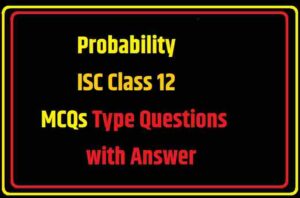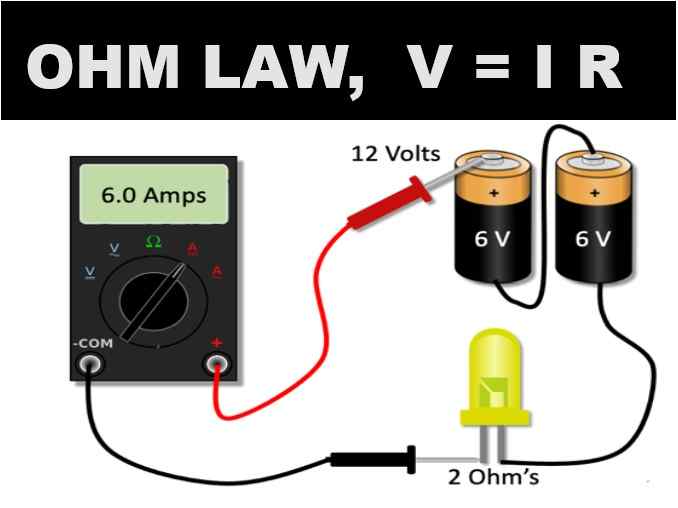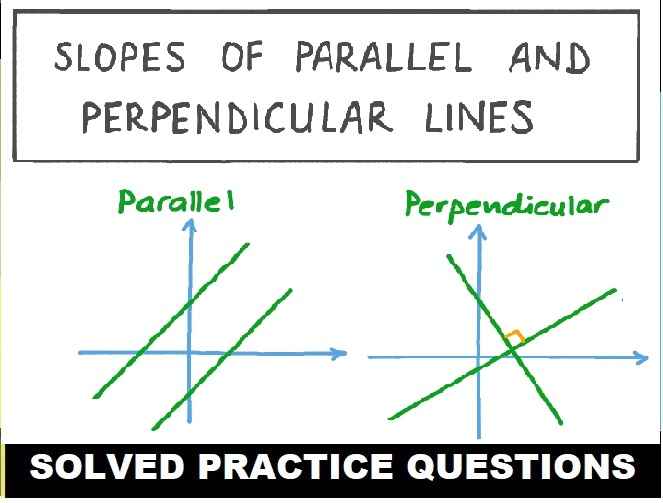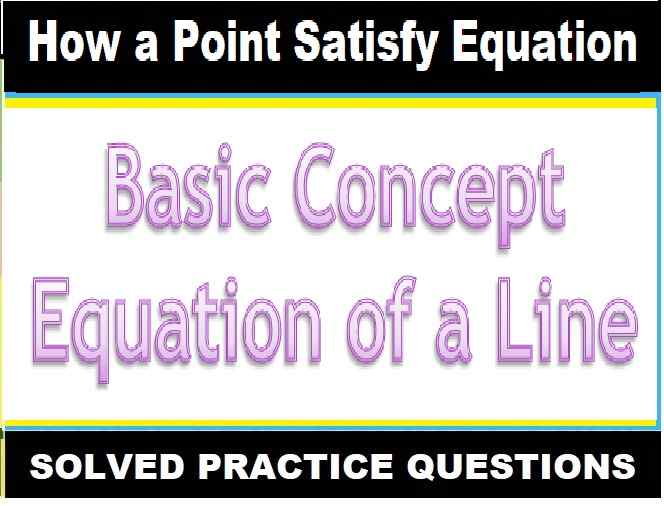Probability ISC Class 12 MCQs Type Questions with Answer. These MCQs / Objective Type Questions is based on latest reduced syllabus according 2021-22 session on bifurcated pattern. Main motto of MCQ Type Question is cracking the next upcoming Sem-2 exam of council. Visit official website CISCE for detail information about ISC Class-12 Maths.
Probability ISC Class 12 MCQs

| Board | ISC |
| Class | 12th (XII) |
| Subject | Maths |
| Chapter | Probability |
| Syllabus | on bifurcated syllabus (after reduction) |
| Session | 2021-22 |
| Bifurcated | Sem-2 |
| Topic | MCQs / Objective Type Question |
Probability ISC Class 12 MCQs Questions with Answers
Question 1: Two dice are thrown once. If it is known that the sum of the numbers on the dice was less than 6 the probability of getting a sum 3 is
(a) 5/18
(b) 1/5
(c) 1/18
(d) 2/5
Answer: (b) 1/5
Question 2: P(A ∩ B) is equal to:
(a) P(A) . P(B|A)
(b) P(B) . P(A|B)
(c) Both A and B
(d) None of these
Answer: (c) Both A and B
Question 3: If A and B are events such that P (A/B) = P(B/A), then
(a) A ⊂ B but A ≠ B
(b) A = B
(c) A ∩ B = ø
(d) P (A) = P (B).
Answer: (d) P (A) = P (B).
Question 4: Two events A and B are said to be independent if:
(a) A and B are mutually exclusive
(b) P (A’B’) = [1 – P(A)] [1 – P(B)]
(c) P (A) = P (B)
(d) P (A) + P (B) = 1.
Answer: (b) P (A’B’) = [1 – P(A)] [1 – P(B)]
Question 5: Let ‘X’ be a discrete random variable assuming values x1, x2, …………… , xn with probabilities p1, p2, …………. , pn respectively. Then variance of ‘X’ is given by
(a) E(X²)
(b) E(X²) + E(X)
(c) E(X²) – [E(X)]²
(d) √𝐸(𝑋)²−[𝐸(𝑋)]²‾‾
Answer: (c) E(X²) – [E(X)]²
Question 6: If P (A) = 6/11, P (B) = 5/11 and P (A ∪ B) = 7/11, what is the value of P(B|A)?
(a) ⅓
(b) ⅔
(c) 1
(d) None of the above
Answer: (b) ⅔
Question 7: If A and B are any two events such that
P (A) + P (B) – P (A and B) = P (A), then:
(a) P (B/A) = 1
(b) P (A/B) = 1
(c) P (B/A) = 0
(d) P (A/B) = 0
Answer: (b) P (A/B) = 1
Question 8: A die is thrown once, then the probability of getting a number greater than 3 is :
(a) 1/2
(b) 2/3
(c) 6
(d) 0
Answer: (a) 1/2
Question 9: If P(A) = 0.4, P(B) = 0.7 and P(B/A) = 0.6. Find P(A ∪ B).
(a) 0.46
(b) 0.86
(c) 0.76
(d) 0.54
Answer: (b) 0.86
Question 10: If P (A) = 0.8, P (B) = 0.5 and P (B|A) = 0.4, what is the value of P (A ∩ B)?
(a) 0.32
(b) 0.25
(c) 0.1
(d) 0.5
Answer: (a) 0.32
Question 11: An urn contains 10 black and 5 white balls. Two balls are drawn from the urn one after the other without replacement. What is the probability that both drawn balls are black?
(a) 3/7
(b) 7/3
(c) 1/7
(d) ⅓
Answer: (a) 3/7
Question 12: If E and F are independent events, then;
(a) P(E ∩ F) = P(E)/ P(F)
(b) P(E ∩ F) = P(E) + P(F)
(c) P(E ∩ F) = P(E) . P(F)
(d) None of the above
Answer: (c) P(E ∩ F) = P(E) . P(F)
Question 13: If P(A) = 0.4, P(b) = 0.8 and P(B|A) = 0.6, then P(A ∪ B) equal to
(a) 0.24
(b) 0.3
(c) 0.48
(d) 0.96
Answer: (c) 0.48
Question 14: A bag contains 4 red and 6 black balls. A ball is drawn at random from the bag, its colour is observed and this ball along with two additional balls of the same colour are returned to the bag.
If now a ball is drawn at random from the bag, then the probability that this drawn ball is red is
(a) 3/10
(b) 2/5
(c) 1/5
(d) 3/4
Answer: (b) 2/5
Question 15: The probability of solving the specific problems independently by A and B are 1/2 and 1/3 respectively. If both try to solve the problem independently, find the probability that exactly one of them solves the problem.
(a) 1
(b) ½
(c) ⅓
(d) ¼
Answer: (b) ½
Question 16: If P(A) = 1/2, P(B) = 0, then P (A/B) is
(a) 0
(b) 1/2
(c) not defined
(d) 1.
Answer: (c) not defined
Question 17: Let A and B be two given independent events such that P(A) =p and P(B) = q and P(exactly one of A, B) = 2/3, then value of 3p + 3q – 6pq is
(a) 2
(b) -2
(c) 4
(d) -4
Answer: (a) 2
Question 18: Let A and B be two given events such that P(A) = 0.6, P(B) = 0.2 and P(A/B) = 0.5. Then P(A’/B’) is
(a) 1/10
(b) 3/10
(c) 3/8
(d) 6/7
Answer: (c) 3/8
Question 19: If P(A ∩ B) = 70% and P(B) = 85%, then P(A/B) is equal to
(a) 14/17
(b) 17/14
(c) 7/8
(d) 1/7
Answer: (a) 14/17
Question 20: Three balls are drawn from a bag containing 2 red and 5 black balls, if the random variable X represents the number of red balls drawn, then X can take values
(a) 0, 1, 2
(b) 0, 1, 2, 3
(c) 0
(d) 1, 2
Answer: (a) 0, 1, 2
Question 21: Probability that A speaks truth is 4/5. A coin is tossed. A reports that a head appears. The probability that actually there was head is:
(a) 4/5
(b) 1/2
(c) 1/5
(d) 2/5
Answer: (a) 4/5
Question 22: If A and B are two independent events, then the probability of occurrence of at least one of A and B is given by:
(a) 1+ P(A′) P (B′)
(b) 1− P(A′) P (B′)
(c) 1− P(A′) + P (B′)
(d) 1− P(A′) – P (B′)
Answer: (b) 1− P(A′) P (B′)
Question 23: If A and B are two events such that P(A) = 0.2, P(B) = 0.4 and P(A∪B) = 0.5, then value of P(A/B) is?
(a) 0.1
(b) 0.25
(c) 0.5
(d) 0.08
Answer: (b) 0.25
Question 24: If A and B are two events such that P (A) ≠ 0 and P (B/A) = 1, then
(a) A ⊂ B
(b) B ⊂ A
(c) B = ø
(d) A = ø
Answer: (a) A ⊂ B
Question 25: If P (A/B) > P (A), then which of the following is correct?
(a) P (B/A) < P (B)
(b) P (A ∩ B) < P (A).P(B)
(c) P (B/A) > P (B)
(d) P (B/A) = P (B).
Answer: (c) P (B/A) > P (B)
Question 26: Let A and B be two events. If P(A) = 0.2, P(B) = 0.4, P(A ∪ B) = 0.6, then P(A/B) is equal to:
(a) 0.8
(b) 0.5
(c) 0.3
(d) 0
Answer: (d) 0
Question 27: If A and B are independent events such that 0 < P(A) < 1 and 0 < P(B) < 1, then which of the following is not correct?
(a) A and B are mutually exclusive
(b) A and B’ are independent
(c) A’ and B are independent
(d) A’ and B’ are independent.
Answer: (a) A and B are mutually exclusive
Question 28: If A and B are two events such that P(A) = 0.2, P(B) = 0.4 and P(A∪B) = 0.5, then value of P(A/B) is?
(a) 0.1
(b) 0.25
(c) 0.5
(d) 0.08.
Answer: (b) 0.25
Question 29: In a binomial distribution, the sum of its mean and variance is 1.8. Find the probability of two successes, if the event was conducted times.
(a) 0.2623
(b) 0.2048
(c) 0.302
(d) 0.305
Answer: (b) 0.2048
Question 30: An experiment has 10 equally likely outcomes. Let A and B be two non-empty events of the experiment. A consists 4 outcomes, the number of outcomes that B must have so that A and B are independent is
(a) 2, 4 or 8
(b) 36 or 9
(c) 4 or 8
(d) 5 or 10
Answer: (d) 5 or 10
Question 31: If the event A and B are independent, then P(A∩B) is equal to
(a) P(i) + P(ii)
(b) P(i) – P(ii)
(c) P(i). P(ii)
(d) P(i) | P(ii)
Answer: (c) P(i). P(ii)
Question 32: Find P(E|F), where E: no tail appears, F: no head appears, when two coins are tossed in the air.
(a) 0
(b) ½
(c) 1
(d) None of the above
Answer: (a) 0
Question 33: If P(A ∩ B) = 70% and P(B) = 85%, then P(A/B) is equal to:
(a) 17/14
(b) 14/17
(c) ⅞
(d) ⅛
Answer: (b) 14/17
Question 34: Let A, B, C be pairwise independent events with P (C) > 0 and P (A∩B∩C) = 0. Then P (Ac∩Bc /C) is
(a) P (A) – P (Bc)
(b) P (Ac) + P (Bc)
(c) P (Ac) – P (Bc)
(d) P (Ac) – P (B).
Answer: (d) P (Ac) – P (B).
–: End of Probability ISC Class 12 MCQs :–
-: also visit :-
- ISC Sem-2 Question Bank Class-12
- Sem-2 ISC Specimen Paper for Class-12
- ISC Class-12 Textbook Solutions ,Syllabus, Solved Paper
- Previous Year Question Paper for ISC Class-12
Please share with your ISC friends if it is helpful
Thanks


